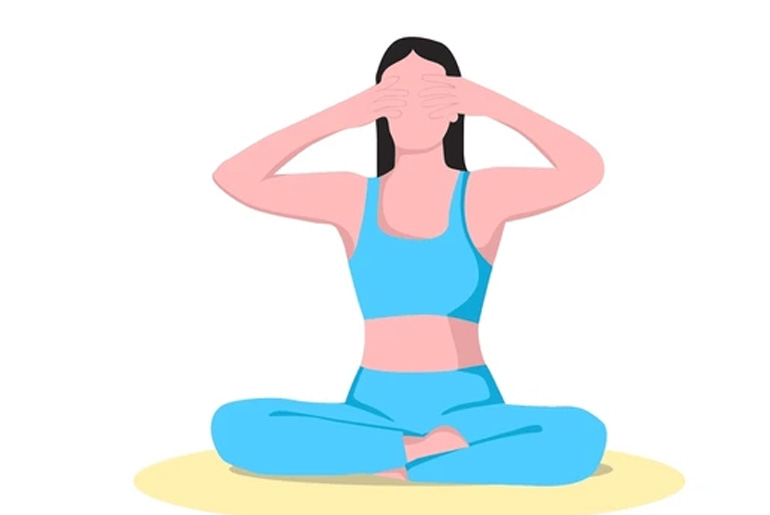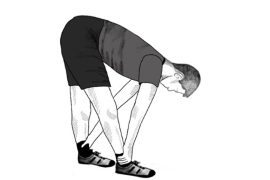Brahmari pranayama is a revered breathing technique in Yoga where practitioners make a humming sound akin to the buzzing of a bee during exhalation. This practice is cherished for its ability to quiet the mind and foster a deeper connection with universal consciousness. By focusing on the gentle humming sound and synchronizing it with controlled breaths, individuals can overcome external distractions and disturbances. Brahmari pranayama promotes mental clarity, emotional balance, and spiritual grounding, making it a valuable tool for enhancing inner peace and mindfulness in daily life.
Health benefits of Brahmari pranayama:
- Calms the Mind: The humming sound produced during Brahmari pranayama has a calming effect on the mind. It helps reduce stress, anxiety, and nervousness, promoting relaxation and mental clarity.
- Relieves Tension: The gentle vibration created by the humming sound massages the facial muscles, releasing tension. This can alleviate headaches, sinusitis, and migraines, providing relief from facial and head-related discomforts.
- Improves Concentration: Regular practice enhances concentration and focus by quieting the internal chatter of the mind. It promotes mindfulness and improves cognitive function, allowing for better attention and mental clarity.
- Balances Emotions: The rhythmic breathing pattern of Brahmari pranayama regulates the autonomic nervous system, which helps in balancing emotions. It aids in managing mood swings and emotional disturbances, fostering emotional stability.
- Reduces Blood Pressure: Deep breathing techniques involved in Brahmari pranayama help lower blood pressure and induce a state of relaxation. This benefit is especially valuable for individuals dealing with hypertension and cardiovascular issues.
- Enhances Sleep Quality: Practicing Brahmari pranayama before bedtime calms the mind and promotes better sleep. It is beneficial for those suffering from insomnia or sleep disorders, as it helps induce a state of relaxation conducive to restful sleep.
- Boosts Immunity: By reducing stress and promoting relaxation, Brahmari pranayama strengthens the immune system. This makes the body more resilient to infections and diseases, supporting overall health and well-being.
- Clears Nasal Passages: The humming sound produced during exhalation helps clear the nasal passages and improve respiratory function. It is particularly beneficial for individuals experiencing allergies, colds, or sinus congestion.
- Elevates Mood: Brahmari pranayama stimulates the release of endorphins, which are neurotransmitters known as “feel-good hormones.” This elevation in mood contributes to a sense of well-being and positivity.
Overall, Brahmari pranayama is a versatile practice that not only promotes physical health by improving respiratory function and reducing blood pressure but also enhances mental well-being by reducing stress, improving concentration, and balancing emotions. Regular practice can significantly contribute to a healthier, more balanced lifestyle.
Steps to Practice Brahmari Pranayama:
Preparation:
- Find a comfortable seated position. You can sit cross-legged on the floor or on a chair with your feet flat on the ground.
- Ensure your spine is comfortably erect. This allows for smooth breathing and better energy flow.
Hand Position (Optional):
- You can use Shanmukhi mudra (closing the ears with your thumbs, index, and middle fingers) to enhance concentration. This involves placing your index fingers on your closed eyelids, your middle fingers on your nostrils, and your thumbs lightly closing your ears.
Breathing Technique:
- Close your eyes gently to focus inward.
- Take a deep inhalation through your nose. Ensure the inhalation is slow, steady, and deep, filling your lungs comfortably with air.
- Exhale slowly and steadily while making a steady humming sound, like the buzzing of a bee. The sound should be continuous and smooth throughout the exhalation.
Humming Sound:
- As you exhale, gently close your lips and begin to make a humming sound. The sound should resonate in your head and throat, creating a soothing vibration.
- Aim for a pitch and volume that feel comfortable for you. The vibration should be felt throughout your head and face.
Duration:
- Start with 5-10 rounds of Brahmari pranayama initially.
- Gradually increase the duration as you become more comfortable with the practice. You can eventually aim for 10-15 minutes of continuous practice.
Mindfulness:
- Throughout the practice, maintain awareness of the humming sound and the sensation of vibration.
- Focus your attention inward, observing the calming effect on your mind and body.
Integration:
- After completing the rounds of Brahmari pranayama, sit quietly for a few moments with your eyes closed.
- Observe any changes in your mental state, physical sensations, or overall well-being.
Safety Tips:
- Listen to Your Body: If you feel any discomfort or strain, adjust the pitch and volume of the humming sound. The practice should be comfortable and soothing.
- Avoid If Congested: If you have a cold, sinusitis, or nasal congestion, it’s best to avoid Brahmari pranayama or practice it gently without forceful exhalations.
- Start Slowly: Begin with a few rounds and gradually increase the duration and intensity over time. This allows your body and mind to adapt to the practice.
- Consistency: Like any pranayama practice, consistency is key to experiencing its full benefits. Aim to practice regularly, ideally daily or several times a week.
Brahmari Pranayama is a powerful technique that promotes relaxation, reduces stress, and enhances mental clarity. With regular practice and mindful attention, you can harness its benefits for a calmer and more balanced mind-body connection.
Additional Tips:
Safety is important when practicing any pranayama technique, including Brahmari Pranayama. Here are some key safety tips to keep in mind:
- Avoid Forceful Exhalations: While practicing Brahmari Pranayama, ensure that the exhalation is gentle and controlled. Avoid forceful exhalations that can strain your throat or respiratory system.
Respect Your Limits: Listen to your body and practice within your comfort zone. If you feel dizzy, light-headed, or uncomfortable at any point, pause the practice and take deep, natural breaths until you feel balanced again.
Modify for Physical Conditions: If you have any respiratory conditions such as asthma or chronic obstructive pulmonary disease (COPD), consult with a healthcare professional or a qualified yoga instructor before practicing Brahmari Pranayama. They can provide guidance on modifications that suit your condition.
Avoid During Acute Illness: If you are currently experiencing a cold, flu, sinusitis, or any other acute respiratory infection, it’s best to avoid practicing Brahmari Pranayama until you have recovered. Pranayama techniques involving nasal breathing may exacerbate these conditions.
Practice in a Safe Environment: Choose a quiet and clean space for your practice where you won’t be disturbed. Ensure good ventilation to support healthy breathing during the practice.
Start Gradually: If you are new to Brahmari Pranayama or pranayama in general, start with a few rounds and gradually increase the duration and intensity over time. This allows your body to adjust to the breathing technique.
Avoid Breath Retention: Unlike some pranayama techniques that involve breath retention (kumbhaka), Brahmari Pranayama focuses on gentle inhalation and exhalation without holding the breath. Avoid holding your breath during this practice to prevent unnecessary strain.
Stay Hydrated: Drink water regularly throughout the day to maintain hydration, which supports healthy respiratory function and overall well-being.
Consult a Professional: If you have any concerns about practicing Brahmari Pranayama or if you experience discomfort during the practice, seek guidance from a qualified yoga instructor or healthcare provider. They can provide personalized advice based on your individual health status.
By following these safety tips, you can practice Brahmari Pranayama effectively and enjoy its benefits while ensuring your well-being and comfort throughout the practice.
Additional Tips:
- Consistency: Regular practice is essential to fully experience the benefits of Brahmari pranayama. Aim for daily practice or integrate it into your routine several times a week for optimal results.
- Integrate with Asanas: Pairing Brahmari pranayama with yoga asanas can amplify its benefits and create a more comprehensive yoga practice. Consider incorporating it before or after your yoga session to enhance relaxation or focus.
- Listen to Your Body: Pay close attention to how your body reacts during and after practicing Brahmari pranayama. If you experience dizziness, light-headedness, or any discomfort, pause the practice and rest until you feel ready to continue. It’s important to prioritize your comfort and well-being throughout your pranayama practice.
Brahmari pranayama is a powerful technique that can be incorporated into your daily routine to promote relaxation, mental clarity, and overall well-being. With regular practice and mindfulness, you can harness its benefits for a calmer and more balanced life.
Disclaimer:
The information contained in this article is for educational and informational purposes only and is not intended as a health advice. We would ask you to consult a qualified professional or medical expert to gain additional knowledge before you choose to consume any product or perform any exercise.








